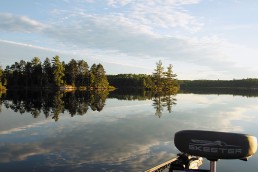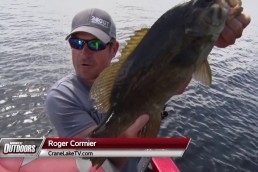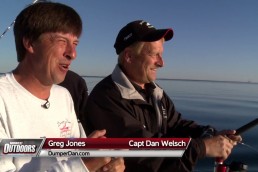Crane Lake–Voyageur’s National Park
SHARE THIS POST
Crane Lake adventure–a multispecies destination
Minnesota offers so many fantastic fisheries, it can be difficult to decide where to go. A perennial favorite remains the Crane Lake Region, located in the northeast part of the state. (About two hours north of Duluth, Minn.). It’s about a five-hour drive from the Twin Cities, approximately ten hours from Chicago. When you arrive, you’ll find yourself on the doorstep of some of the best fishing opportunities in the upper Midwest!
Crane Lake is located on the edge of Voyageur’s National Park and the Superior National Forest. While many folks vacation here simply to enjoy the peaceful setting, the region is best-known as a water-based park. Boating and fishing are top priorities for visitors and locals alike. Three primary lakes, Crane Lake, Sand Point Lake, and Namakan Lake, comprise the main waterway of over 40,000 combined acres.
Several rivers and streams pour into and out of the system. Some even can be accessed by unique “mechanical portages.” These consist of a railway track and flatbed boat trailer that cradles a watercraft. Then, the trailer hauls it up and over a hill to deposit it on a completely different lake on the other side. Anglers find their way to more remote fishing spots in this way. Likewise, canoe outfitters and guides in the area take advantage of the mechanical portages to penetrate deeper into the Boundary Waters Canoe Area Wilderness (BWCAW). Eventually, even into waterways where no motorized craft are permitted.
Wishing for some walleyes?
Walleye is the Minnesota State Fish. It’s certainly, also, a priority for fishermen who visit here. The region also offers saugers, a closely-related cousin of the walleye. Fishing for both species can be easy on the Crane Lake Chain, especially in the spring. Then, the fish are primarily holding in shallow water. Pitching light jigs, tipped with minnows or plastics, along rocky shorelines produces numbers of fish. Also, with so much water percolating through these connected lakes and rivers, ample current areas provide well-oxygenated habitat. Consequently, several gamefish species, such as walleyes and northern pike, frequent the area. Prime current locations to choose include the Vermilion Gorge, the Loon River, and the Namakan River. Tere are numerous other backwaters and bays with inflows and outflows that you can discover during your vacation in Crane Lake.
Pike on the prowl
Speaking of pike, spring is an ideal time to target larger specimens, while they are still holding in shallow water. Pike migrate to mud-bottom backwater shallows after the spawn. They find the warmest water, get their slow metabolisms cranked up, and feed. They are voracious feeders once their blood has warmed. Big northern pike even will devour unsuspecting ducklings paddling amongst emergent vegetation in these backwaters!
As long as water temps in these areas remain below 60 degrees, you’ll enjoy success fishing for shallow pike. Warming water drives these fish out of bays and into the deeper, cooler basin areas of the main lakes. There, they are much harder to catch consistently. When fishing the shallows in spring, choose topwater lures (especially “walk-the-dog” options like Storm’s #11 or #13 Topwalker), or a 3/4-ounce buzzbait. Larger fluke-style or paddle-style soft plastics (or a large-profile stickworm)—especially in variations of white, silver, or grey—rigged weedless are another key choice. Or, toss a white spinnerbait or #14 Husky Jerk for variety in your presentation and even more success.
Don’t become an illegal alien
When fishing and boating on Minnesota/Ontario border waters, you have the option to access both sides of the lakes and rivers. You’ll need to be aware of where “water borders” are located. Make sure you have the proper paperwork/proof of citizenship. Also, carry Ontario fishing licenses if you intend to fish on the Ontario side of the border. There are both U.S. and Canadian Customs offices located in Crane Lake. The check-in process is easy. I’ve always found the Canadian officials to be friendly and welcoming. Prefer to stay only in U.S. waters? Navigation is as simple as staying on the east or south half of the waterway.
As an additional navigation aide, the main channels, as well as hazard areas on the U.S. side of the lakes, are well-marked with buoys. Also, excellent paper maps are available if you don’t have GPS at hand.
Are you enjoying this post?
You can be among the first to get the latest info on where to go, what to use and how to use it!
Bass grow big up here
Smallmouth bass offer true trophy potential in these northern Minnesota waters. In recent years, word has spread across the U.S. about Crane Lake smallmouths. Bass anglers come from far and wide to enjoy the great fishing. Fifteen years ag,o the overwhelming majority of vacationers arrived here towing a deep-V-style, multi-species or walleye boat. It’s much more common to see sleek bass boats plying these waters, today. That being said, because the Crane Lake Chain features such a vast amount of navigable water, overall boat traffic is much less than what you’ll encounter on popular southern waters. Despite being a Boundary Waters region, there are no motor restrictions on the main Crane Lake waterways.
Smallmouth bass fishing is good in spring, summer and fall. The early part of the season often offers the best action for both numbers and size of bronzebacks. An 18-inch fish is considered a “trophy,” and these specimens are numerous in Crane Lake. We enjoy an annual family trip on these lakes, booked with Voyagaire Houseboats. Last year, my boys both invited several of their friends along to share the experience. All the kids were blessed with previous angling experience, but not so much as far as targeting smallmouth bass. Each boy caught and released trophy fish between 18 and 19 inches during our houseboat vacation!
Get the scoop on bass fishing from Gary Klein.
Tagging bronzebacks with topwaters
Springtime bass relate to rocky shorelines and shallow reefs near spawning areas. This makes them particularly easy to catch, especially on topwater lures. For my money, this is the most fun way for kids to catch big fish (other than, perhaps, walleyes under a bobber). Besides surface poppers and prop baits, several other tactics are top producers for Crane Lake smallmouths. Plastic worms (4- or 5-inch) in shades of coffee or orange—rigged on a #4 or #5 wide gap hook like a VMC Fastgrip—imitate crayfish perfectly. If you rig the presentation with the hook point covered, it’s easy to fish in shallow, rocky areas.
Tube jigs work similarly well. Sometimes the nose of the bait dives between boulders and wedges your fishing line more easily. Kids, especially, can struggle with fishing tubes in areas with lots of rocky cover. Instead, choose tubes when fishing in areas dominated by gravel and sand, with minimal rocks. And, speaking of rocks, when patrolling the shallows, be sure to don polarized eyewear. Pitch both topwaters and soft plastics to every large boulder you see. If bass aren’t spotted cruising the shallows, you can be sure a few are hiding close to cover such as large rocks. Other good lures for Crane Lake bass include #3 or #4 inline spinners like Blue Fox or Mepps (choose gold patterns), jerkbaits, and short-bodied wobbling crankbaits like Storm’s Wiggle Wart or Rapala’s Scatter Rap Crank Deep. Stick with popular crayfish colors.
Multispecies Mecca
Crane Lake is truly a multi-species destination. It’s among Minnesota’s finest spots to catch a variety of fish. Besides the popular gamefish noted above, you also can target lake trout, black crappies, sturgeon, perch, bluegills, and largemouth bass. And there’s so much more to see and do. Besides fishing, you can enjoy nature hikes, bird-watching, wildlife viewing, boating and swimming. Or, explore the history of the region.
Crane Lake is a perfect family destination. A number of resorts offering varying price points and levels of amenities, shops and restaurants, a full-service marina with boat and pontoon rentals as well as repair services, fly-in services to access remote lakes, fishing guides, and canoe outfitters provide every manner of service for visitors to the Crane Lake area. Now is the time to start planning your trip to this spectacular region of northern Minnesota!
MWO
SHARE THIS POST
Did you enjoy this post?
You can be among the first to get the latest info on where to go, what to use and how to use it!



